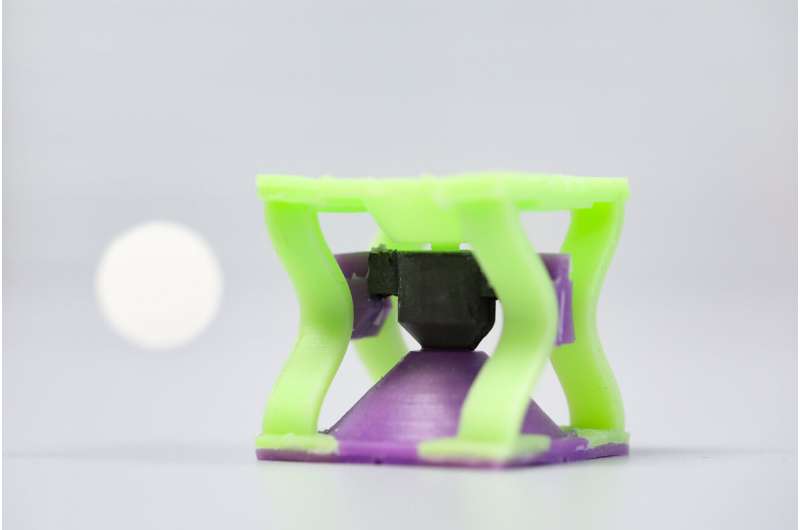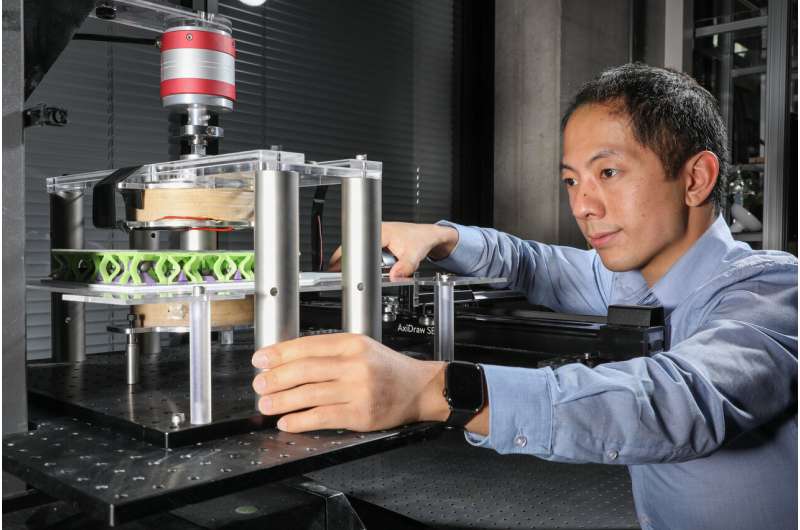New metamaterial offers reprogrammable properties

Over the past 20 years, scientists have been developing metamaterials, or materials that don't occur naturally and whose mechanical properties result from their designed structure rather than their chemical composition. They allow researchers to create materials with specific properties and shapes. Metamaterials are still not widely used in everyday objects, but that could soon change. Tian Chen, a post-doc at two EPFL labs—the Flexible Structures Laboratory, headed by Pedro Reis, and the Geometric Computing Laboratory, headed by Mark Pauly—has taken metamaterials one step further, developing one whose mechanical properties can be reprogrammed after the material has been made. His research appears in Nature.
A single material with several mechanical functions
"I wondered if there was a way to change the internal geometry of a material's structure after it's been created," says Chen. "The idea was to develop a single material that can display a range of physical properties, like stiffness and strength, so that materials don't have to be replaced each time. For example, when you twist your ankle, you initially have to wear a stiff splint to hold the ankle in place. Then as it heals, you can switch to a more flexible one. Today you have to replace the entire splint, but the hope is that one day, a single material can serve both functions."
Silicon and magnetic powder
Chen's metamaterial is made of silicon and magnetic powder and has a complicated structure that allows mechanical properties to vary. Each cell within the structure behaves like an electrical switch. "You can activate and deactivate individual cells by applying a magnetic field. That modifies the internal state of the metamaterial, and consequently its mechanical properties," says Chen. He explains that his programmable material is analogous to computer devices like hard drives. These devices contain bits of data that can be written to and read from in real time. The cells in his programmable metamaterial, called m-bits, work like the bits in a hard drive—they can be switched on, making the material stiffer, or off, making it more flexible. And researchers can program various combinations of on and off to give the material exactly the mechanical properties they need at any given time.
To develop his material, Chen drew on methods from both computer science and mechanical engineering. "That's what makes his project so special," says Pauly. Chen also spent a considerable amount of time testing his material in each of its different states. He found that it could indeed be programmed to achieve various degrees of stiffness, deformation and strength.

Many research horizons
Programmable metamaterials are akin to machines, such as robots, that employ complicated, energy-intensive electronic mechanisms. With his research, Chen aims to find the right balance between static materials and machines. Reis sees a lot of potential for further research using Chen's technology. "We could design a method for creating 3-D structures, since what we've done so far is only in 2-D," Reis says. "Or we could shrink the scale to make even smaller metamaterials." Chen's discovery marks a fundamental step forward, as it is the first time scientists have developed a truly reprogrammable mechanical metamaterial. It opens up many exciting avenues for research and cutting-edge industrial applications.
More information: A reprogrammable mechanical metamaterial with stable memory, Nature (2021). DOI: 10.1038/s41586-020-03123-5 , www.nature.com/articles/s41586-020-03123-5
Journal information: Nature
Provided by Ecole Polytechnique Federale de Lausanne





















